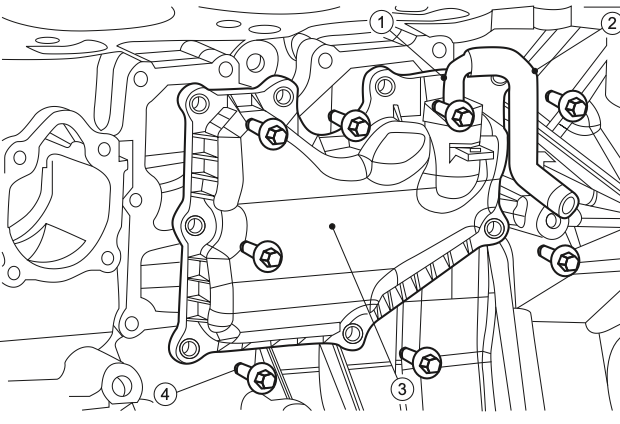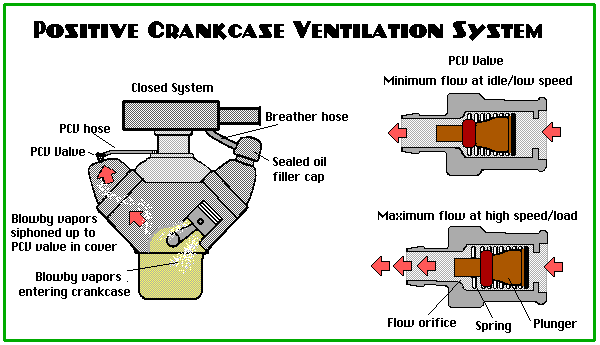Positive crankcase ventilation, also known as PCV, is a vital system found in almost all modern vehicles. It was first introduced in the 1960s as a means to reduce harmful emissions and improve fuel economy.
The PCV system is designed to regulate and control the pressure in the engine’s crankcase, which is the space below the pistons in the engine block. The crankcase contains oil and is sealed to prevent leaks and maintain a vacuum. If the pressure inside the crankcase is too high, it can cause leaks or other engine problems.
The PCV system consists of several components, including a valve, hoses, and a breather filter. The PCV valve is the heart of the system and is usually located on the valve cover or intake manifold. It regulates the flow of air into and out of the crankcase, ensuring that the pressure remains at the correct level.
The PCV system works by drawing in fresh air from the intake manifold and directing it into the crankcase. This fresh air helps to remove any unwanted gases and moisture that may have accumulated in the oil. The PCV valve also allows any excess pressure to escape, preventing damage to the engine.

One of the primary benefits of the PCV system is that it reduces harmful emissions. When the engine is running, it produces a variety of gases, including hydrocarbons and carbon monoxide. These gases can be harmful to both the environment and human health. The PCV system helps to reduce these emissions by trapping them in the engine and directing them back into the intake manifold to be burned off.
Another benefit of the PCV system is that it can improve fuel economy. By reducing the pressure in the crankcase, the engine has to work less to push the pistons, which can lead to a slight increase in fuel efficiency.
Maintaining the PCV system is relatively simple and can be done as part of regular engine maintenance. The PCV valve should be inspected and replaced if necessary, and the hoses and breather filter should be checked for any signs of wear or damage.
In summary, the PCV system is an essential component of any modern vehicle. It helps to regulate the pressure in the engine’s crankcase, reduce harmful emissions, and improve fuel economy. By understanding how the system works and maintaining it regularly, you can ensure that your vehicle runs smoothly and efficiently for years to come.
The PCV system is essential because if the pressure in the crankcase is too high, it can cause a variety of problems. For example, it can cause oil leaks or damage to the engine’s seals and gaskets. High pressure can also cause oil to blow out of the engine’s dipstick or other places, which can lead to a loss of lubrication and engine damage.
On the other hand, if the pressure in the crankcase is too low, it can cause a vacuum, which can lead to oil leaks or other engine problems. The PCV system helps to regulate the pressure in the crankcase, ensuring that it remains at the correct level for optimal engine performance.
The PCV valve is a critical component of the PCV system because it controls the flow of air into and out of the crankcase. Over time, the valve can become clogged with debris or fail altogether, which can cause problems with the engine. That’s why it’s essential to inspect the valve regularly and replace it if necessary.
In addition to reducing emissions and improving fuel economy, the PCV system can also help to extend the life of your engine. By removing harmful gases and moisture from the oil, the system helps to prevent corrosion and other types of engine damage.
Overall, the PCV system is an essential part of any modern vehicle. By maintaining the system regularly, you can ensure that your engine runs smoothly and efficiently, while reducing harmful emissions and extending the life of your vehicle.
Advantages of Positive Crankcase Ventilation (PCV):
- Reduced Emissions: The PCV system helps reduce harmful emissions by trapping unwanted gases and moisture in the engine and directing them back into the intake manifold to be burned off.
- Improved Fuel Economy: By reducing the pressure in the crankcase, the engine has to work less to push the pistons, which can lead to a slight increase in fuel efficiency.
- Better Engine Performance: The PCV system helps maintain the correct pressure in the crankcase, preventing leaks, and engine damage.
- Increased Engine Life: By removing harmful gases and moisture from the oil, the system helps to prevent corrosion and other types of engine damage, extending the life of the engine.
Disadvantages of Positive Crankcase Ventilation (PCV):
- Increased Oil Consumption: In some cases, the PCV system can cause increased oil consumption. This can occur if the valve fails or if the system becomes clogged, leading to oil leaks and other engine problems.
- Requires Maintenance: The PCV system requires regular maintenance to ensure that it’s working correctly. If the valve becomes clogged or fails, it must be replaced to prevent engine damage.
- Potential for Engine Damage: If the PCV system is not maintained or if it fails, it can cause engine damage. High pressure or low pressure in the crankcase can lead to oil leaks, engine damage, or even engine failure.
- Can Affect Engine Performance: If the PCV system is not functioning correctly, it can affect engine performance, leading to poor acceleration or decreased power.
Overall, the advantages of the PCV system outweigh the disadvantages, but it’s essential to maintain the system regularly to prevent potential problems.










